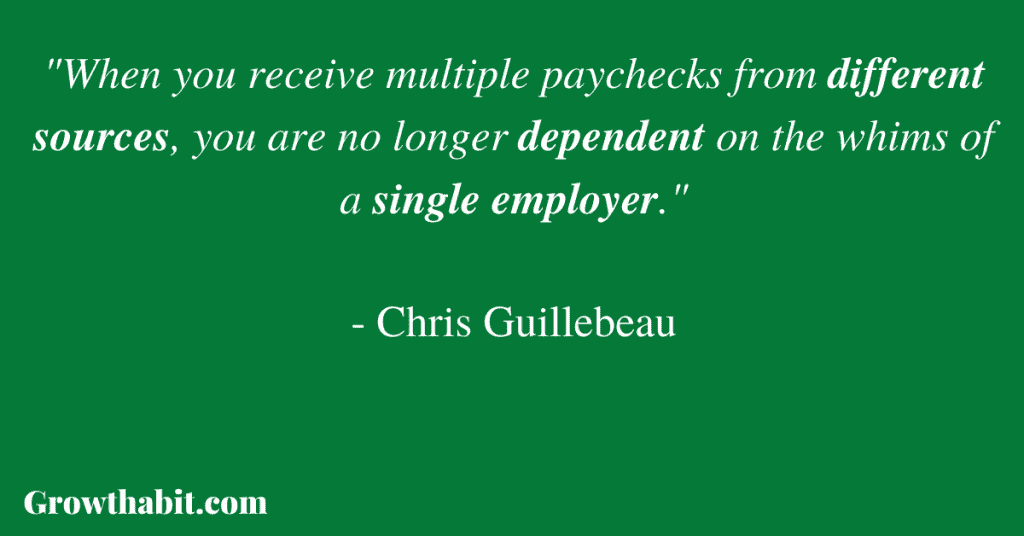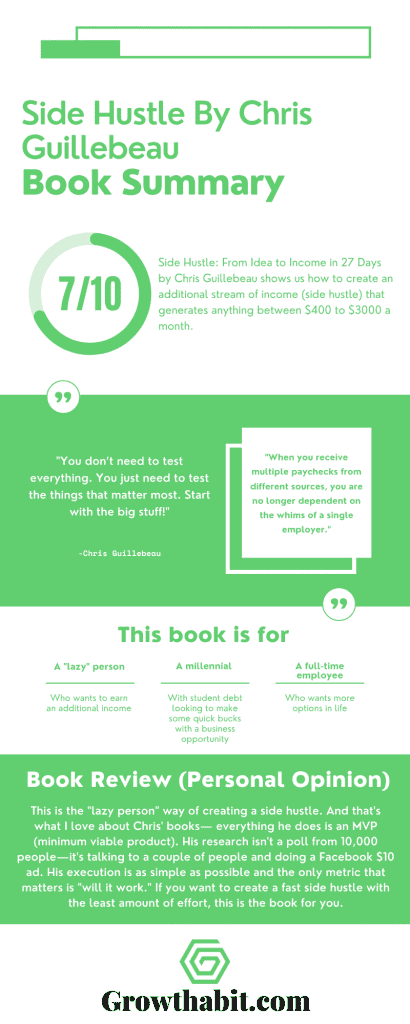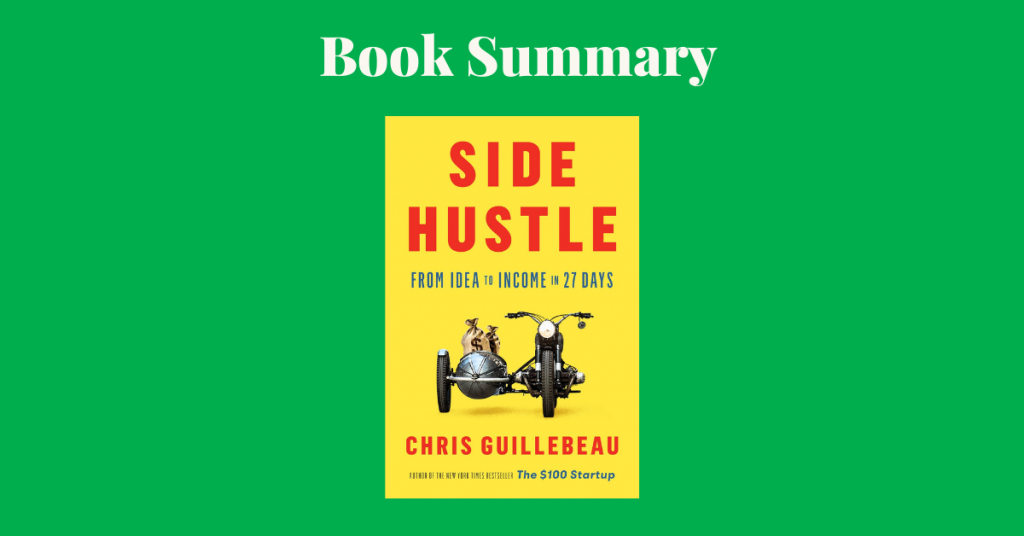Side Hustle: From Idea to Income in 27 Days by Chris Guillebeau shows us how to create an additional stream of income (side hustle) that generates anything between $400 to $3000 a month.
Book Title: Side Hustle: From Idea to Income in 27 Days
Author: Chris Guillebeau
Date of Reading: October-November 2017
Rating: 7/10
What Is Being Said In Detail:
Side Hustle is just about that— how to create an additional income stream. Guillebeau has structured the book as a how-to that helps you create a side hustle in 27 days.
The book has 5 sections:
Week 1: Build an arsenal of ideas
Week 1 is all about learning how to build the right idea. Because a side hustle starts with the right idea(s) that work— and they work if they’re feasible, profitable, and persuasive.
Week 2: Select your best idea
Week 2 is all about figuring out what idea from the previous week is the best one. After you’ve picked one, then it’s about creating a perfect buyer’s persona, studying other people to figure out how to do it differently, and create an offer.
Week 3: Prepare for liftoff
Last week was about finding the right persona— this week is about helping that person learn why they can’t live without your offer. You’re also creating your price and the way to get paid in week 3.
Week 4: Launch your idea to the right people
After you planned and prepared, now it’s time to launch. This week is about learning the tricks of the trade when it comes to testing, marketing, and selling.
Week 5: Regroup and refine
Week 5 is about optimizing and creating systems. You optimize by tracking the most important metrics (profit, growth, time) and then taking action according to data. You probably have systems in place, but they are stored in your head. Get them out of your head so you can work on those systems.
Most Important Keywords, Sentences, Quotes:
When you receive multiple paychecks from different sources, you are no longer dependent on the whims of a single employer.
Did you ever hear the saying that money doesn’t grow on trees? Parents sometimes say this to their kids when the kids want to buy everything in sight. These parents are only half right. Money does grow on trees—you just have to plant the right seeds, in the right soil. In each short chapter of this book, you’ll read a story of someone who found a money tree and made it blossom—simply by putting an idea into action. Along the way, you’ll learn how to uncover and unlock a replicable process you can tailor to your own hustle.

You don’t need much money. You don’t need much time.
For more than twenty years, I’ve made a good living doing everything from importing coffee to building websites. Somewhere in that time, I also spent several years as an aid worker in West Africa, then pursued (and finished) a quest to visit every country in the world. If you asked me how to be a better employee, I wouldn’t know what to tell you. But if you want to know how to create a new source of income, I can guide you each step of the way.
Do you like the idea of having more than one source of income?
Are you willing to devote at least thirty minutes a day to building your hustle, for at least the next twenty-seven days?
Week 1: Build an arsenal of ideas
START A PROJECT: you’re actually going to do this, not just think about it. When you think about an idea, do you feel excited? Can you envision your next steps? If not, abandon the idea.
THAT EARNS MONEY: remember, a side hustle is not a hobby. A side hustle produces income. If you don’t see a clear way to get paid, abandon the idea.
IN A SHORT PERIOD OF TIME: if your idea requires three years to get going, abandon the idea.
High-potential ideas have characteristics like these:
• A simple path to turn the idea into reality that you can describe in one sentence
• Something that you know how to do or can easily figure out
• Solves a problem or makes someone’s life easier in a specific way (and that they will be willing to pay for)
• Is low maintenance and easy to deliver without a ton of preparation or follow-up
• Will bring in income not just once but on a recurring basis
Generally speaking, there are three broad categories of side hustles. You can sell a product, whether one of your own or someone else’s, you can provide a service, or you can be a middleman of some kind.
Week 2: Select your best idea
FEASIBILITY: The ability to begin turning the idea into action in a short period of time
PROFITABILITY: The potential to make money from this idea, also in a short period of time
PERSUASION: Not only is this a good idea, it’s a good idea now
Your reconnaissance mission doesn’t need to be complicated. You just want to learn two things:
1. Who else is offering the same thing or something similar
2. How your idea will be better or different
Do you have $10? Have you ever used Facebook? I’m guessing the odds are 99 percent or higher that the answer to both questions is yes. If you have a big idea and want to get some real-world feedback (not just from your friends) before going further, you can set up an advertisement and see how people respond. No need to rent a billboard—with Facebook you can get it going in less than an hour and as little as $10.

He took out a piece of paper and began writing about that imaginary person. He called him “Jimmy,” and he added a ton of details about him. Jimmy was thirty-four years old and a married father of two kids. His wife was a stay-at-home mom, and every day Jimmy drove exactly twenty-seven minutes to his office, where he worked from a cubicle.
People often think, “I don’t want to leave anyone out,” John Lee told me. “But that’s wrong! This is scarcity thinking. When you focus all your efforts on that one person who is perfect for you, you’ll actually end up serving many more.”
A complete offer includes the following elements.
THE PROMISE: how your hustle will change someone’s life
THE PITCH: why they should purchase or sign up now
THE PRICE: what it costs to purchase or sign up (and how to do it)
That’s because the story of Corala Cashmere is a great origins story: a compelling and inspiring narrative of the why behind their side hustle. No matter what it is you’re selling, you need an origins story, too.
I’ve always been interested in _________, so I decided to try _________.
I was frustrated by _________ and knew there was a better way. I made _________ to help other people with the same problem.
I started this hustle because I noticed _________. There didn’t seem to be anyone else doing anything about it (or the existing businesses were missing something important), so I made _________.
Week 3: Prepare for liftoff
1. What will people experience after purchasing your offer?
2. What needs to happen for you to deliver that experience to them?
Payment schedules can vary, but since we’re keeping it simple, you probably want to choose one of these three:
• Payment in full prior to beginning work
• Partial payment prior to beginning work, the rest at completion
• Payment in full when the work is completed
Week 4: Launch your idea to the right people
Two friends start an “Uber for Lawncare” hustle with the goal of serving lawn care professionals, figuring it out as they go along (they end up making more than $1 million a year)
At the end of this course, users will________.
By buying this widget, customers will ________.
I will improve my clients’ lives by ________.
“Leave your dog with me and feel less guilty for abandoning him all day”—but they very well might say, “With my pet-sitting service, your dog will be loved, walked, played with, and cared for while you’re away from
home.” See how it works?
“I just went to everyone’s house and said, ‘Can I have a $30,000 donation for the Girl Scouts?’ “When they said ‘No,’ I said, ‘Would you at least buy a box of Girl Scout cookies?’ ” She ended up selling more than $80,000 worth of cookies.
You don’t need to test everything. You just need to test the things that matter most. Start with the big stuff!
Here are the big three:
1. Your product or service (what you offer)
2. Your offer (how you present it)
3. Your price (how much it costs)
• Long vs short copy on your sales page
• Word order, especially in headlines and calls to action
• Website navigation and user experience
• Free trial vs low-priced trial (or vs no trial)
• Testimonials from happy customers vs experts’ ratings or reviews
• Hard sell vs soft sell (or both)
SCARCITY: “There are only a limited number of items! I’ll miss out if I don’t buy one.”
URGENCY: “The deal is going to go away soon. I’ll miss out if I don’t buy it now.”
Week 5: Regroup and refine
…metrics in three key areas:
• Profit (income minus expenses)
• Growth (number of new prospects, customers, or clients)
• Time (how many hours per week you spend starting and operating the project)
Always remember that a hustle is different from other startup ventures or businesses. You don’t have to listen to the advice of experts or follow conventional wisdom. You don’t have to “scale.” You don’t have to hire employees or assistants, virtual or otherwise. There is no single “right way.”
There’s only the right way for you.

Book Review (Personal Opinion):
This is the “lazy person” way of creating a side hustle. And that’s what I love about Chris’ books— everything he does is an MVP (minimum viable product). His research isn’t a poll from 10,000 people—it’s talking to a couple of people and doing a Facebook $10 ad. His execution is as simple as possible and the only metric that matters is “will it work.” If you want to create a fast side hustle with the least amount of effort, this is the book for you.
Rating: 7/10
This Book Is For (Recommend):
- A “lazy” person who wants to earn an additional income
- A millennial with student debt looking to make some quick bucks with a business opportunity
- A full-time employee who wants more options in life
If You Want To Learn More
Here’s Chris talking about his book at FinCon 2017.
FinCon 2017
How I’ve Implemented The Ideas From The Book
I did a version of the”$10 Facebook ad.” I wrote an article about my habit reading program and shared it with a couple of people. The article received 68 comments where people asked to receive my habit tracker and 160 people subscribed to the newsletter. Although that was 2 years ago and I didn’t immediately follow up on the feedback, it was enough to validate the idea. And voilà, Growthabit was born out of that.
One Small Actionable Step You Can Do
Every, out of the 27 steps, is a small one. But if I would have to pick one, it would be the “$10 ad.” It’s about writing an article about your side hustle idea and putting out a $10 Facebook ad to see if people would like to know more/subscribe to the idea. It’s one of the easiest (and cheapest) ways to validate a side-hustle idea.
